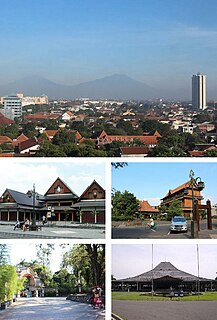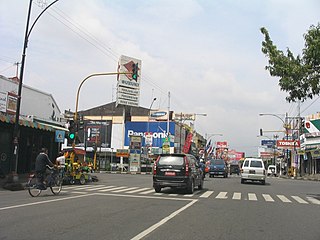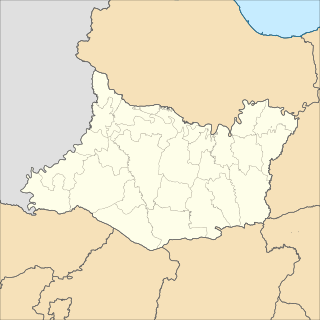This article provides insufficient context for those unfamiliar with the subject.(June 2017) |
Wadaslintang is an Administrative village in District Wadaslintang, Wonosobo Regency, Central Java Province. [1] Wadaslintang have postal code 56365. [2]
This article provides insufficient context for those unfamiliar with the subject.(June 2017) |
Wadaslintang is an Administrative village in District Wadaslintang, Wonosobo Regency, Central Java Province. [1] Wadaslintang have postal code 56365. [2]
Word Wadaslintang from two words Wadas and Lintang, Wadas mean stone and Lintang (in Indonesian Bintang) mean bright. [3] From etymology Wadaslintang means bright stone.
Wadaslintang have 4 Dusun [4] (Hamlets):
According to Wonosobo Central Agency on Statistics, Wadaslintang Village population in 2014 are: [5] 4570 inhabitants.
List Wadaslintang Village Chief from 1834 until 1998 [6]
There are many schools in Wadaslintang [7]

Surakarta, known colloquially as Solo, is a city in Central Java, Indonesia. The 44 km2 city adjoins Karanganyar Regency and Boyolali Regency to the north, Karanganyar Regency and Sukoharjo Regency to the east and west, and Sukoharjo Regency to the south. On the eastern side of Solo lies Solo River. Its built-up area, consisting of Surakarta Municipality and 59 districts spread over seven regencies, was home to 3,649,254 inhabitants as of 2010 census.

Malang is a landlocked city in the Indonesian province of East Java. It has a history dating back to the age of Singhasari Kingdom. It is the second most populous city in the province, with a population of 820,043 at the 2010 Census and 843,810 at the 2020 Census. Its metropolitan area is home to 3,663,691 inhabitants in 2010, spread across two cities and 22 districts. Malang is the third largest city by economy in East Java, after Surabaya and Kediri, with an estimated 2016 GDP at Rp. 44.30 trillion.
A regency is an administrative division of Indonesia, directly under a province. The Indonesian term kabupaten is also sometimes translated as "municipality". Regencies and cities are divided into districts.

Purwokerto is a large but non-autonomous town on the island of Java, Indonesia. It is the capital of Banyumas Regency, Central Java region. The population of the town at the 2010 Census was 233,951 and 229,271 at the 2020 Census.

Salatiga is a city in Central Java province, Indonesia. It covers an area of 56.781 km2 and had a population of 192,322 at the 2020 Census. Located between the cities of Semarang and Surakarta, and administratively an independent city enclaved within Semarang Regency, it sits at the foot of Mount Merbabu (3,142 m) and Mount Telomoyo, and has a relatively cool climate due to its elevated position. Salatiga is a part of the Semarang metropolitan area.

Magelang is a regency in Central Java, Indonesia, famous for its 9th century Buddhist temple of Borobudur. Its capital is Mungkid. It covers an area of 1,085.73 km2 and had a population of 1,181,723 at the 2010 Census and 1,299,859 at the 2020 Census. These figures exclude the autonomous city of Magelang, which is separately administered but is geographically enclaved within the regency, which borders Temanggung Regency to the north, Semarang Regency to the northeast, Boyolali Regency to the east, the Special Region of Yogyakarta to the south and southeast, Purworejo Regency to the southwest, and Wonosobo Regency to the west. Its motto is Magelang Gemilang.
Gesang is a small town located the Tempeh subdistrict of East Java, approximately 30 minutes drives from Lumajang and 4 hours from Surabaya. It borders the towns of Jokarto (North), Pulo (East), Jatisari, Semumu (South) and Nguter (West).

The Sangihe Islands Regency is a regency of North Sulawesi Province, Indonesia. It comprises a group of islands situated to the North of Sulawesi. It covers a land area of 736.98 km2, and had a population of 126,100 at the 2010 Census and 139,262 at the 2020 Census. The principal island is also named Sangihe, on which lies the main town of Tahuna. Minor island groups within the Regency include the Marore group considerably to the north of Sangihe Island, the Tatoareng group to the south, and the Nusa Tabukan group off the northeast coast of Sangihe Island. It borders the Philippines in the north, making it one of Indonesia's border regions.

Anggabaya is a small village in Bali, Indonesia.

The Lampung people are an ethnic group indigenous to Lampung province and parts of South Sumatra province of the southern and central region that occupy areas such as Martapura, Muaradua at upstream of Komering River, Kayu Agung, Tanjung Raja at downstream of Komering River, Merpas on the southern side of Bengkulu province, as well as Cikoneng in the southwest coast of Banten province, Indonesia. They speak the Lampung language, a Lampungic language estimated to have 1.5 million speakers.

Prof. Suyanto, Ph.D. is a professor and technocrat from Indonesia. He had been a rector of Yogyakarta State University and Director General for Management of Primary and Secondary Education in Indonesian Ministry of Education and Culture. He is also known as a writer and speaker in education. His current positions are as a Vice Chairman of Majelis Pendidikan Tinggi Pimpinan Pusat Muhammadiyah and Chairman of Alumni Association of Yogyakarta State University.

Bojonegoro District is a town which serves as the capital of Bojonegoro Regency, East Java, Indonesia.

Rawaseneng Monastery is a monastery complex of the Catholic Order of Cistercians of the Strict Observance (O.C.S.O.), popularly known as the Trappists, located in Temanggung Regency, Central Java, Indonesia. The monastery was officially established on 1 April 1953 as a daughter house of Koningshoeven Abbey in Tilburg, Netherlands. Apart from being a residence for the monks, there are also a church, prayer garden, retreat houses, coffee plantations, dairy farms along with the processing industries within the monastery complex. Ronald Bell, a pilgrim from the United States, shares his impression about this place, "You will get all the stages, praying, meditating, contemplating sacred readings, and working. All of those constitute an inseparable part of the experience." Not far from the monastery complex, it lies the Church of Santa Maria dan Yoseph as the center of the Rawaseneng Parish, just ahead of the Kindergarten and Elementary School of Fatima Rawaseneng which are managed by the Dominican nuns.
Mante people or also spelled as Mantir, are one of the earliest ethnic group frequently mentioned in legendary folklore to have inhabited Aceh, Indonesia. This ethnic group along with other indigenous people such as the Illanun people, Sakai people, Jakun people, Senoi and Semang, are the ethnic groups that formed the existing Acehnese people today. The Mante people are regarded as part of the Proto-Malay people group that initially settled around the region of Aceh Besar Regency and in the interior jungle. These indigenous people were thought to have migrated to Aceh through the Malay peninsula. In the Acehnese legend, the Batak and Mante people were mentioned as the descendants of Kawom Lhèë Reutōïh ; which were also one of the indigenous peoples in Aceh, Indonesia. Today, this people are extinct or have disappeared as a result of intermarriage with other non-indigenous people groups that arrived later. To date, there are still no strong scientific evidence for the existence of this people.
In Indonesian law, the term "city" (kota) is generally defined as the second-level administrative subdivision of the Republic of Indonesia, an equivalent to regency (kabupaten). The difference between a city and a regency is that a city has non-agricultural economic activities and a dense urban population, while a regency comprises predominantly rural areas and is larger in area than a city. However, Indonesia historically had several classifications of cities.

Jukung tambangan is a traditional boat made by the Banjar people of South Kalimantan. They are mainly used for riverine transportation. It is already present at least since mid-18th century. They were not seen anymore in Banjarmasin ca. 1950s and around the 1970s on the Nagara River, Hulu Sungai Selatan Regency.

North Sumedang is a district in Sumedang Regency, West Java, Indonesia which serves as the regency seat of Sumedang Regency. It is located halfway along the provincial route connecting Bandung and Cirebon. The Cisumdawu Toll Road is planned to connect to the district in 2021, to ease travels and economic activities between Bandung, Sumedang and Kertajati International Airport.

Brebes Sundanese is the dialect of Sundanese language used by some people in Brebes Regency, Central Java, especially in the southern and southwestern parts of the region. The area of Brebes Regency is one of the districts in Central Java which borders the West Java region.